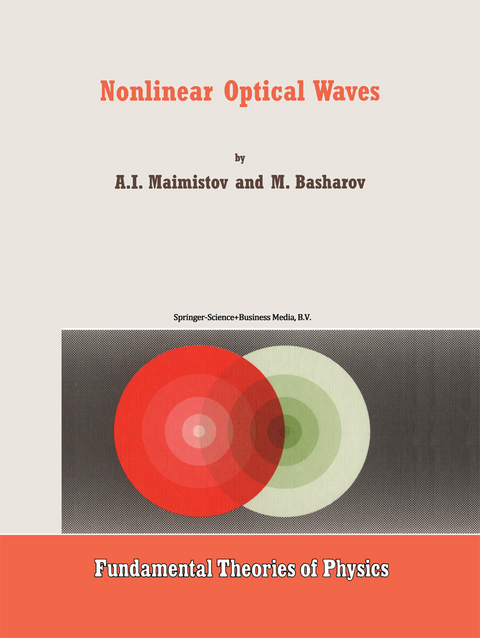
Nonlinear Optical Waves
Seiten
1999
Springer (Verlag)
978-0-7923-5752-0 (ISBN)
Springer (Verlag)
978-0-7923-5752-0 (ISBN)
A non-linear wave is one of the fundamental objects of nature. All non-linear waves can be divided into two parts: dispersive waves and dissipative ones. Now solitons have become the primary components in many important problems of nonlinear wave dynamics. This book had been designed as the tutorial to the theory of non-linear waves in optics.
A non-linear wave is one of the fundamental objects of nature. They are inherent to aerodynamics and hydrodynamics, solid state physics and plasma physics, optics and field theory, chemistry reaction kinetics and population dynamics, nuclear physics and gravity. All non-linear waves can be divided into two parts: dispersive waves and dissipative ones. The history of investigation of these waves has been lasting about two centuries. In 1834 J. S. Russell discovered the extraordinary type of waves without the dispersive broadening. In 1965 N. J. Zabusky and M. D. Kruskal found that the Korteweg-de Vries equation has solutions of the solitary wave form. This solitary wave demonstrates the particle-like properties, i. e. , stability under propagation and the elastic interaction under collision of the solitary waves. These waves were named solitons. In succeeding years there has been a great deal of progress in understanding of soliton nature. Now solitons have become the primary components in many important problems of nonlinear wave dynamics. It should be noted that non-linear optics is the field, where all soliton features are exhibited to a great extent. This book had been designed as the tutorial to the theory of non-linear waves in optics. The first version was projected as the book covering all the problems in this field, both analytical and numerical methods, and results as well. However, it became evident in the process of work that this was not a real task.
A non-linear wave is one of the fundamental objects of nature. They are inherent to aerodynamics and hydrodynamics, solid state physics and plasma physics, optics and field theory, chemistry reaction kinetics and population dynamics, nuclear physics and gravity. All non-linear waves can be divided into two parts: dispersive waves and dissipative ones. The history of investigation of these waves has been lasting about two centuries. In 1834 J. S. Russell discovered the extraordinary type of waves without the dispersive broadening. In 1965 N. J. Zabusky and M. D. Kruskal found that the Korteweg-de Vries equation has solutions of the solitary wave form. This solitary wave demonstrates the particle-like properties, i. e. , stability under propagation and the elastic interaction under collision of the solitary waves. These waves were named solitons. In succeeding years there has been a great deal of progress in understanding of soliton nature. Now solitons have become the primary components in many important problems of nonlinear wave dynamics. It should be noted that non-linear optics is the field, where all soliton features are exhibited to a great extent. This book had been designed as the tutorial to the theory of non-linear waves in optics. The first version was projected as the book covering all the problems in this field, both analytical and numerical methods, and results as well. However, it became evident in the process of work that this was not a real task.
1. Basic equations.- 2. Coherent transient phenomena.- 3. Inverse Scattering Transform method.- 4. Self-Induced Transparency.- 5. Coherent Pulse Propagation.- 6. Optical solitons in fibres.- 7. Parametric interaction of optical waves.- 8. Non-linear waveguide structures.- 9. Thin film of resonant atoms: a simple model of non-linear soptics.- Appendix 1. The density matrix equation of a system in broadband thermostat.- Appendix 2. The density matrix equation for a gas medium.- Appendix 3. Adiabatic following approximation.- Appendix 4. Relation between exactly integrable models in resonance optics.
| Erscheint lt. Verlag | 30.6.1999 |
|---|---|
| Reihe/Serie | Fundamental Theories of Physics ; 104 |
| Zusatzinfo | XIV, 656 p. |
| Verlagsort | Dordrecht |
| Sprache | englisch |
| Maße | 155 x 235 mm |
| Themenwelt | Naturwissenschaften ► Physik / Astronomie ► Allgemeines / Lexika |
| Naturwissenschaften ► Physik / Astronomie ► Elektrodynamik | |
| Naturwissenschaften ► Physik / Astronomie ► Optik | |
| Naturwissenschaften ► Physik / Astronomie ► Theoretische Physik | |
| ISBN-10 | 0-7923-5752-3 / 0792357523 |
| ISBN-13 | 978-0-7923-5752-0 / 9780792357520 |
| Zustand | Neuware |
| Informationen gemäß Produktsicherheitsverordnung (GPSR) | |
| Haben Sie eine Frage zum Produkt? |
Mehr entdecken
aus dem Bereich
aus dem Bereich
für Studierende der Natur- und Ingenieurwissenschaften
Buch | Hardcover (2023)
Hanser (Verlag)
39,99 €
Band 1: Mechanik und Thermodynamik
Buch | Softcover (2022)
Wiley-VCH (Verlag)
39,90 €


